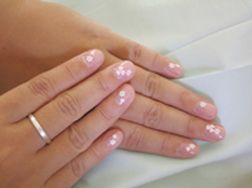Fingernails tell a thousand tales

19.JAN.07
We see our hands over a hundred times a day, but do we examine them? Probably not! Lets start with our fingernails. Do you know that they are a good indicator of our overall health? Our fingernails reveal whether we are deficient in vitamins, minerals, or whether our system is digesting food well. They can also reveal other conditions such as heart disease or diabetes. So, what do you see when you look at your fingernails? Do you see a healthy pink nail bed with a smooth, perfectly curved surface? Or do you see discoloration, dents, white spots, ridges, hangnails or irregular shaping of the nails? While some of these marks are not cause for concern, fingernail symptoms are a sign of something happening in our bodies that may require medical attention.{{more}}
WHAT DO WE KNOW ABOUT OUR FINGERNAILS?
Our fingernails, like our hair, are made of a protein called keratin. Nails protect the fingertips from trauma and injury; plus they help make it easier to pick things up. Scraping surfaces or prying anything open can damage your nails. Fingernails are made of a number of components such as, the nail body or nail plate which is visible when you look at your fingers. Anchored to the nail plate is the nail bed, which is a layer of sensitive skin. The skin surrounding the nail plate is referred to as the âfolds.â The skin that folds around the nail plate is the cuticle. The whitish half-moon shape found at the base of the nail is called the lunula. (Lunulae-Plural). Nails grow from under the cuticle in a place called the matrix.
A nail grows about.004 inches a day or 1/8 of an inch a month. It takes approximately six months for a new nail to grow from cuticle to tip. Harsh chemicals and household cleaning products can delay nail growth. To prevent this, wear gloves as a protector for your hands. To maintain healthy nails, it is important to moisturize your hands with skin protective cream every day, eat healthy foods (fruits, vegetables, meats, and grains), drink at least eight glasses of water and exercise daily.
WHAT ARE SOME OF THE SIGNS?
The following are some of the more common nail problems due to deficiencies in our body and what they mean. Some may be related to health issues, others could be nail injury or nail trauma.
1. Nails that curb under at the tips may indicate heart or respiratory problems, raised nail base may also indicate respiratory concerns.
2. Square and wide nails may indicate hormonal disorder.
3. Flat and thin nails may indicate vitamin deficiency particularly vitamin B-12
A. WHITE SPOTS ON NAILS – May indicate a zinc deficiency or injury or trauma.
B. BRITTLE NAILS – Vitamin A, calcium or Iron deficiency may indicate thyroid problems, kidney problems, or poor circulation.
C. SPLITTING-VERTICAL NAILS – calcium deficiency may indicate tendency to develop arthritis.
D. YELLOWISH DISCOLORATION – May indicate fungus, psoriasis or possible liver problems.
E. FLAT SPOON SHAPED NAILS – Vitamin B-12 deficiency may indicate anemia or thyroid disease.
F. THICK NAILS – may indicate blood is not circulating properly.
G. NAILS THAT CHIP OR CRACK EASILLY – May indicate nutritional and/or mineral deficiency.
H. DOWNWARD CURVED NAIL ENDS – heart, liver may indicate respiratory problems.
I. WHITE MOON AREA TURN RED – May indicate heart problems.
J. WHITE MOON AREA TURN BLUE – May indicate lung problems over exposure to silver.
K. LENGHWISE GROOVES – May indicate kidney disorders, iron deficiency.
L. HORIZONTAL RIDGES – May indicate kidney disorders, iron deficiency.
M. YELLOW NAILS – May indicate diabetes, liver problems, respiratory and lymph.
N. CLUBBED PURPLE NAILS, RISE UPWARD AND CURL AROUND THE FINGER – May indicate lung, colon, or heart disease.
O. PITTED NAILS – May indicate psoriasis, eczema or parasites.
P. DENTED NAILS – May indicate trauma or nail injury.
So, when we look at our hands, look for what they are revealing. Do a fingernail analysis starting with your thumb, then your index or forefinger, your middle finger, ring finger, then your little finger. Healthy fingernails start with a healthy lifestyle. Your nails should be smooth without spots, hollows or ridges. Eat healthy foods, exercise, drink at least eight glasses of water a day, get plenty of rest and regular check-ups from your doctor. To restore fingernails to their natural beauty, they require daily maintenance including a bi-weekly visit to the salon for a manicure and a paraffin dip with moisturizer and protein softeners.
For the best manicure/pedicure and body massages, itâs Nails by Design Salon. Located @ Sion Hill intersection of the Main Rd. Gap to Dorsetshire Hill. Ph. 456-4505. E-mail: tiptoe.nails@gmail.com
Randa P. Velox
Nail Technician/Consultant









